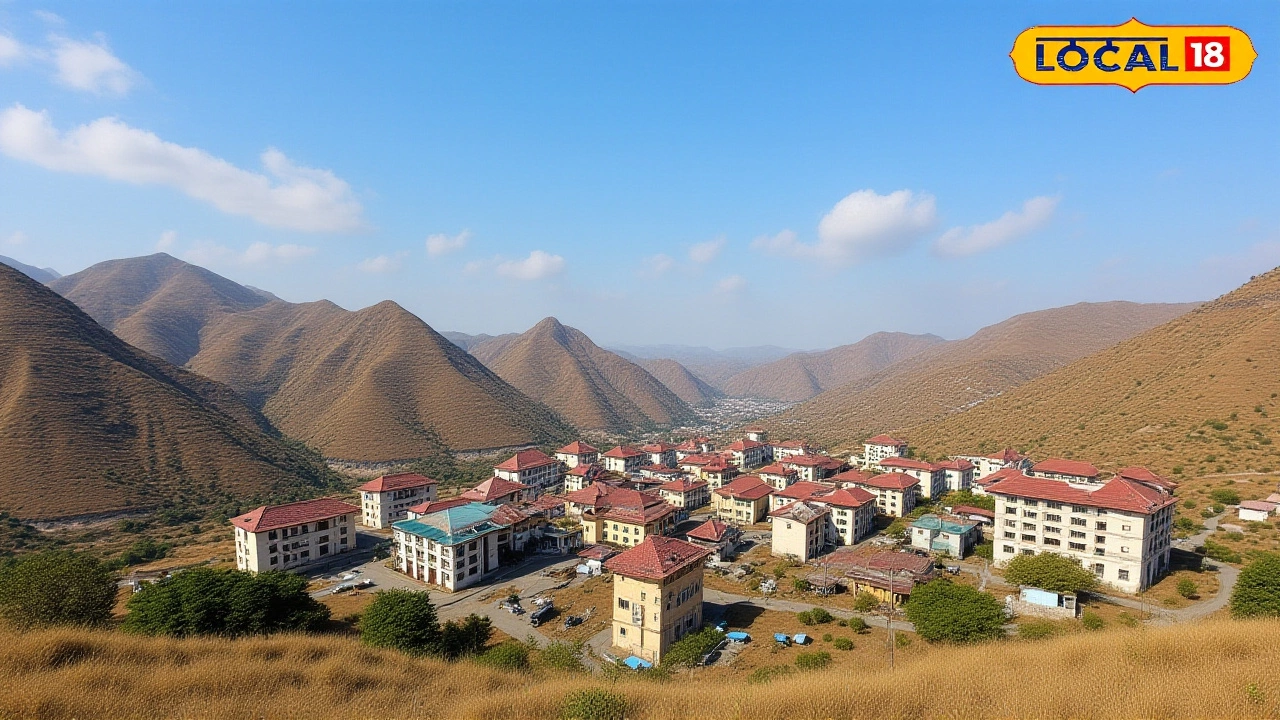The India Meteorological Department issued a Yellow alert for 23 districts in Rajasthan on October 30, 2025, as Cyclone Montha sent a deep depression racing northward from the Bay of Bengal, dumping torrential rain, triggering lightning storms, and sending temperatures plunging across the state. Schools shut down. Roads flooded. Visibility dropped to near zero. And farmers—some relieved, others devastated—watched the skies with mixed emotions. This wasn’t just a monsoon leftover. It was a rare, intense weather event fueled by an unusual tropical system, and it hit Rajasthan hard.
What Happened in Rajasthan?
Between October 27 and 30, 2025, the India Meteorological Department recorded moderate to heavy rainfall across Udaipur, Kota, Ajmer, Jodhpur, Jaipur, and Bharatpur divisions. The most intense bursts came on the evening of October 29, when the Sangod area in Kota district saw 16 millimeters of rain in just 15 minutes. Water pooled on streets, cars stalled, and local residents scrambled to secure homes. Meanwhile, Dausa district experienced its first dense fog of the season—visibility plunged below 100 meters on National Highway 21, forcing vehicles to crawl at walking speed on the morning of October 30.
Temperatures crashed. In Bhilwara, the maximum hit just 19.6°C—13.7°C below normal. Kota recorded 30°C, two degrees below average, with overnight lows at 21.1°C. That kind of drop in a region that typically sees highs above 35°C in late October? Unusual. And it wasn’t just a fluke. The IMD confirmed the system was tied to Cyclone Montha’s outer circulation, which pulled moisture deep into the normally dry western states.
Who Got Hit and How?
The 23 districts under Yellow alert included Nagaur, Barmer, Jalore, Jodhpur, Pali, Ajmer, Sirohi, Udaipur, Bhilwara, Chittorgarh, Rajsamand, Jhunjhunu, Sikar, Tonk, Jaipur, Dausa, Alwar, Bharatpur, Dholpur, Karauli, Sawai Madhopur, Baran, and Kota. But the impacts weren’t evenly spread. Udaipur and Kota divisions bore the brunt, with clouds lingering for four to five days. The rest of Rajasthan cleared by October 31.
Education took a hit. On October 30, schools across the state closed—no exceptions. Jagran Josh reported it as a statewide precaution. Parents in Jaipur and Ajmer said they were grateful for the decision. “We’ve seen kids caught in lightning before,” said Priya Mehta, a mother of two in Jaipur. “Better safe than sorry.”
For farmers, it was a double-edged sword. In Kota and Baran, standing paddy crops—ripe and ready for harvest—were flattened by heavy rain and wind. “We were days away from cutting,” said farmer Ram Singh in Baran. “Now half the field’s waterlogged. The grain’s rotting.” But others, especially those preparing for Rabi sowing, welcomed the moisture. “The soil was parched,” said Anjali Devi, a smallholder in Sirohi. “This rain means we can sow wheat without irrigation. That’s a blessing.”
What the IMD Warned—and What’s Next
The India Meteorological Department didn’t mince words. Its October 30 bulletin stated: “Thunderstorm with lightning East Rajasthan on 29th and 30th October.” It urged residents to stay indoors, avoid trees, and unplug appliances. The warning was urgent—and followed. In Udaipur, local authorities activated emergency response teams. Power lines were inspected. Emergency shelters opened.
What comes next? The IMD forecasts that Udaipur and Kota divisions will see intermittent showers through November 3, but the rest of Rajasthan will turn dry by November 1. No more major temperature swings are expected in the next week. But the lingering question is: Why now?
Cyclone Montha formed over the southeastern Bay of Bengal on October 25, intensified into a deep depression by October 27, and then veered northwest—something rarely seen this late in the season. Normally, cyclones in this region move west toward Gujarat or south toward Tamil Nadu. This one turned inland. Experts say warming sea surface temperatures in the Bay may be playing a role. “We’re seeing more erratic tracks,” said Dr. Rajiv Mehta, a climatologist at the Indian Institute of Tropical Meteorology. “The monsoon withdrawal is delayed, and systems are lingering longer. That’s the new normal.”

Broader Implications
This wasn’t isolated. On October 30, the IMD also warned of very heavy rain in Bihar, thunderstorms in West Bengal and Sikkim, and downpours in Vidarbha. The pattern suggests a broader shift in monsoon behavior—possibly linked to climate variability. Rajasthan, historically drought-prone, is now grappling with sudden, violent rainfall events that overwhelm infrastructure.
Transport networks remain vulnerable. National Highways 21 and 76 saw delays. Rail services between Jaipur and Kota were disrupted for hours. Hospitals reported a spike in lightning-related injuries and respiratory cases from damp, moldy homes.
And while the immediate storm is fading, the questions remain: Are our drainage systems built for this? Do rural communities have early-warning access? And why do we only react after the damage is done?
What’s Next?
The IMD will continue monitoring the remnants of Cyclone Montha through November 2. A new system is forming in the Arabian Sea, but its path is still uncertain. For now, Rajasthan is catching its breath. But officials say they’re reviewing emergency protocols. “We can’t keep playing catch-up,” said a senior IMD official speaking anonymously. “We need better localized forecasts—and faster community alerts.”
Frequently Asked Questions
Why did Cyclone Montha affect Rajasthan when it’s usually a coastal phenomenon?
Cyclone Montha formed over the Bay of Bengal and intensified into a deep depression that moved unusually northwest instead of west. This path pulled moisture deep into Rajasthan, a region that rarely sees cyclone-level systems this late in the year. Warming sea temperatures and shifting wind patterns are making such inland excursions more common.
How did the rainfall impact agriculture in Rajasthan?
In Kota and Baran, standing paddy crops were damaged by flooding and wind, with some farmers losing up to 40% of their harvest. But for others preparing Rabi crops like wheat and mustard, the rain was a godsend—reducing irrigation needs and improving soil moisture. The net effect is mixed, but overall, it’s a relief after three years of below-average rainfall.
Why did Dausa experience dense fog after the rain?
The overnight rainfall cooled the ground significantly, and with high humidity lingering in the air, moisture condensed rapidly at dawn. This created dense fog with visibility under 100 meters—common in northern India during winter, but unusual in late October. The drop in temperature from 35°C to 21°C overnight made it possible.
Were schools closed statewide because of safety or just precaution?
It was both. Thunderstorms with lightning posed direct physical danger, especially in rural areas where school buildings lack lightning rods. Plus, waterlogged roads and poor visibility made travel risky. The state education department acted preemptively—similar to how schools close during snow in the north. No injuries were reported, but officials say it was the right call.
Is this a sign of climate change affecting Rajasthan’s weather patterns?
Yes. Rajasthan has seen a 30% increase in extreme rainfall events since 2010, according to IMD data. While individual storms can’t be blamed solely on climate change, the frequency and intensity of systems like Cyclone Montha align with global climate models predicting more erratic monsoon behavior in arid regions.
What should residents do if another alert is issued?
Stay indoors during thunderstorms, avoid open fields and tall trees, unplug electronics, and keep emergency numbers handy. Download the IMD’s official app for real-time alerts. If you live in low-lying areas, prepare sandbags and elevate valuables. Local authorities will issue evacuation orders if needed—don’t wait for them to knock on your door.
